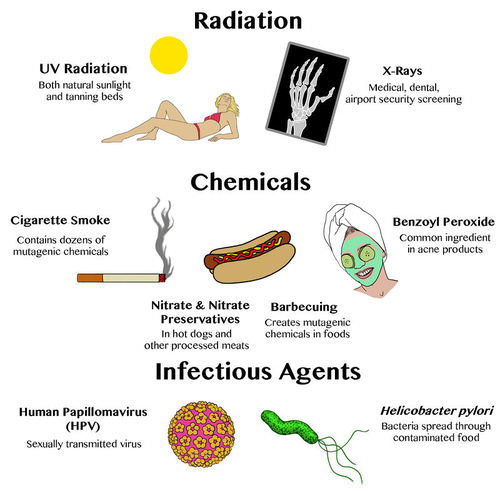MUTAGENESIS
MUTAGENESIS
Mutagenesis is the process through which genetic mutations are induced or occur spontaneously in an organism's DNA. These mutations can lead to changes in the structure or function of proteins, and they play a crucial role in evolution, development, and disease.
1. Types of Mutagenesis
Spontaneous Mutagenesis: Occurs naturally due to errors in DNA replication, spontaneous chemical changes, or environmental factors.
Induced Mutagenesis: Resulting from exposure to external agents (mutagens) that increase the rate of mutations. This includes:
- Chemical Mutagens: Substances that cause mutations through chemical reactions, such as base analogs, alkylating agents, and intercalating agents.
- Physical Mutagens: Environmental factors like ultraviolet (UV) light and ionizing radiation (X-rays, gamma rays) that can cause DNA damage.
- Biological Mutagens: Some viruses can integrate their genetic material into the host DNA, leading to mutations.
2. Mechanisms of Mutagenesis
- Point Mutations: A change in a single nucleotide, which can lead to silent, missense, or nonsense mutations.
- Insertions and Deletions: Addition or loss of nucleotides that can cause frameshift mutations, altering the reading frame of the gene.
- Chromosomal Mutations: Larger-scale changes, such as duplications, deletions, inversions, or translocations of chromosome segments.
3. Effects of Mutagenesis
- Beneficial Mutations: Can provide an advantage in survival and reproduction, contributing to evolution.
- Neutral Mutations: Have no significant effect on the organism’s fitness.
- Harmful Mutations: Can lead to genetic disorders, cancer, or other diseases.
4. Applications of Mutagenesis
- Genetic Research: Studying gene function and regulation through induced mutations.
- Biotechnology: Developing organisms with desirable traits, such as increased resistance to diseases in crops or producing pharmaceuticals.
- Medicine: Understanding the mechanisms of diseases, particularly cancer, which often involves mutations in key genes.
5. Detection and Analysis
- Mutation Assays: Various techniques are used to detect mutations, including sequencing, PCR-based methods, and reporter assays.
- Model Organisms: Organisms like yeast, fruit flies (Drosophila), and mice are often used in research to study mutagenesis and its effects.


Comments
Post a Comment